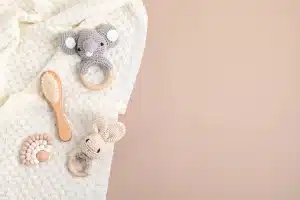The History and Cultural Significance of Rattles and Baby Toys
Introduction
Baby toys have been an integral part of human civilization for thousands of years. Among the wide variety of baby toys available, rattles hold a special place due to their rich history and cultural significance. In this article, we will explore the fascinating journey of rattles and baby toys throughout the ages, highlighting their features and shedding light on their importance in various societies.
Early Beginnings: Prehistoric Rattles
As early as the Paleolithic era, archaeological evidence suggests that humans created primitive baby toys, including rattles made from animal bones and shells. These early rattles served not only as sources of amusement but also as instruments for developing motor skills and improving hand-eye coordination in infants.
- Simple yet effective—early rattles were constructed from organic materials such as hollowed-out bones or shells.
- The rattling sound produced by these toys intrigued babies and helped stimulate their audio perception.
- Primitive societies also believed that rattles protected infants from evil spirits and brought good luck to their lives.
Evolution: Development of Rattles
As civilizations advanced, so did the sophistication of baby toys. The evolution of technology and human craftsmanship paved the way for the development of more complex rattles.
- Materials and design—rattles were crafted from a variety of materials, including clay, wood, silver, and gold, and were often adorned with intricate carvings and precious gemstones.
- Symbolic significance—rattles in ancient cultures were often associated with rituals and religious ceremonies, representing fertility, protection, and the link between the physical and spiritual realms.
- Regional variations—different cultures developed unique styles of rattles, showcasing their artistic heritage and cultural identity.
Cultural Significance of Rattles and Baby Toys
Rattles hold significant cultural value in various societies around the world. Here are some examples of their cultural significance:
- Native American culture—rattles played a central role in Native American traditions, used during ceremonies, dances, and healing rituals to invoke spiritual energy and establish a connection with the supernatural.
- African heritage—rattles, often made from gourds or seeds, are prevalent in African cultures. They are used in music, storytelling, and as a means of communication during celebrations and spiritual gatherings.
- Asian influence—many Asian countries, such as India and China, have a rich history of using rattles and baby toys as symbolic offerings and auspicious gifts during religious festivals and newborn celebrations.
Contemporary Rattles and Baby Toys
In modern times, rattles and baby toys have evolved to meet the needs of today’s parents and infants. With advancements in technology, materials, and design, contemporary baby toys offer a wide array of features:
- Developmental stimulation—modern rattles are designed to support cognitive, sensory, and motor development in infants, featuring bright colors, various textures, and interactive elements.
- Safety and eco-consciousness—manufacturers prioritize using non-toxic materials and implementing strict safety standards to ensure the well-being of babies. Eco-friendly options made from sustainable materials have also gained popularity.
- Interactive and educational features—baby toys now incorporate lights, sounds, and even smartphone connectivity to engage and educate infants, offering a multi-sensory learning experience.
Conclusion
The journey of rattles and baby toys is a testament to our innate desire to nurture and stimulate infants. From primitive bone and shell rattles to contemporary interactive toys, these objects have played a crucial role in the development of children for countless generations. Understanding the rich history and cultural significance of rattles broadens our appreciation for these small yet significant artifacts that continue to bring joy and aid in the growth of our youngest ones.





